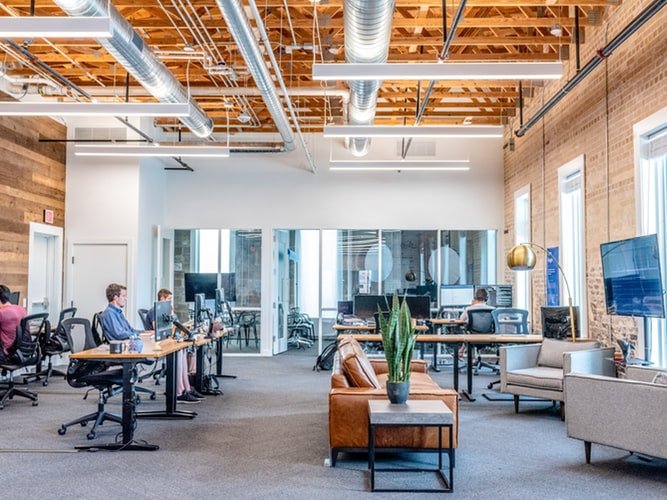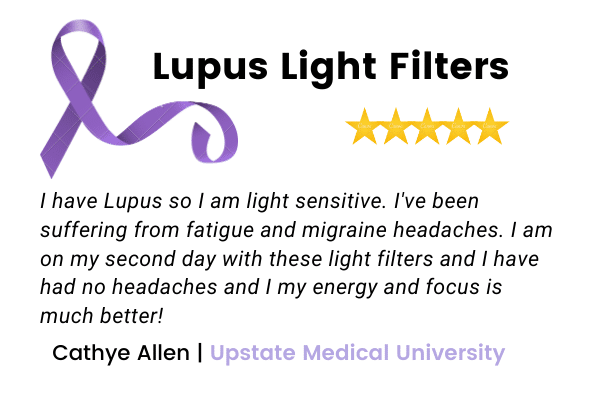If exposure to UV light causes your lupus symptoms to worsen, you’re not alone. In fact, there is even a connection between lupus and fluorescent lights.
Photosensitivity affects 40% to 70% of people with lupus. All people are affected by extended exposure to UV light. Sunburn is the most common reaction. However, for those suffering from photosensitivity, the symptoms can be almost instantaneous and much more severe.
The effects of UV exposure to people with photosensitivity may include rash, extreme sunburn, blisters, headaches, and even fever.
People with lupus suffer many of the same symptoms as anyone with photosensitivity. However, UV light can also cause long term effects and lupus flare-ups. These flare-ups can cause weakness, joint pain, skin lesions, headaches, fever, and fatigue that may last for a few hours or up to several weeks.
If you suffer from photosensitivity related to lupus, you’ve likely developed techniques to help protect you from the effects of the sun. Unfortunately, that may not be enough. Fluorescent lights found inside public places like your grocery store or even your workplace can emit UV rays and lead to lupus flare-ups.
Table of Contents
Lupus and Fluorescent Lights
Fluorescent bulbs produce UV light. While UVA and UVB rays aren’t supposed to escape from these light fixtures, cracks in the phosphor coating or improperly shielded bulbs can lead to exposure. When people with lupus experience continued exposure to these rays, flare-ups may result.
While many people understand that UV light is emitted by some types of indoor light, the effects of these limited rays are often disputed. Fluorescent lamps created to replace incandescent light bulbs effectively save energy, but they emit more UV light.
Fluorescent bulbs contain an electric current in a low-pressure mercury vapor, which produces UV light. When the UV strikes the phosphor coating on the inside of the bulb, white light is emitted. Cracks in this phosphor coating allow UV light to leak. For people with lupus, cumulative exposure to UVB and UVA rays from unshielded fluorescent light can have serious repercussions.
For many people suffering photosensitivity, the symptoms resolve after the trigger is removed. In lupus patients, this may not be the case. To understand the interaction between lupus and fluorescent lights, we have to consider the treatments and nature of the disease.
Increased sensitivity related to lupus and even medications designed to reduce lupus symptoms can make your reaction to fluorescent lights more severe. Even worse, the reaction can trigger flare-ups that may last for weeks and ultimately be dangerous to your long-term health.
Medications and Photosensitivity
Many medicines have side-effects that increase photosensitivity. In fact, 400 drugs are known to cause photosensitivity and photoallergic reactions. Many prescriptions and even topical creams can elevate your sensitivity to UV rays. Some common medicines that cause photosensitivity include:
- Tetracycline antibiotics
- Antihistamines
- Antidepressants
- Blood pressure medications
- Anti-inflammatory drugs like ibuprofen
- Sleep aids like melatonin and Rozerem
- Methotrexate is a prescription medication that fights swelling and joint pain caused by lupus. However, it also increases photosensitivity.
Lupus Symptoms Affected by Fluorescent Lights
In the same way that people react differently to sun exposure, sensitivity levels to fluorescent lights vary widely. The UV rays emitted by these lights is significantly lower than that produced by the sun, but exposure is typically longer. Your level of sensitivity may not be triggered by a trip to the supermarket but if you work in this type of lighting daily, it can seriously affect your health. Both short-term immediate symptoms and flare-ups that create long-term symptoms can occur from fluorescent light exposure.
Short term symptoms
- Rash or hives
- Headaches and migraines
- Painful burning or prickling skin sensations
- Eye sensitivity
Flare-up symptoms from cumulative exposure
- Fever
- Joint pain and swelling
- Skin discoloration and lumps
- Hair loss
- Slower recovery from flare-ups
- Persistent weakness and fatigue
- Mouth ulcers or sore throat
- Severe flares can affect organs and require hospitalization
Solutions for Blocking Dangerous UV Rays at Work
Changing your home to eliminate your exposure to dangerous UV rays is challenging enough, but finding ways to protect yourself in public can be even more demanding. Avoid symptoms indoors with the same ways you protect your skin outdoors. There are also additional steps you can take to eliminate the source of UV exposure at work.
The Americans with Disabilities Act is a set of laws that require employers to provide accommodations for workers who suffer from disabling conditions aggravated by work conditions. Accommodations aren’t a type of special treatment. They are a variety of simple solutions tailored to the symptoms of workers who need them.

Here are a variety of solutions you and your employer can use to help alleviate symptoms related to lupus and fluorescent lights.
Move your desk
If your desk is located near a window that allows sunlight to reach your workspace, moving is a simple and effective solution. The Americans with Disabilities Act (ADA) requires your employer to allow certain accommodations to help you succeed at work without posing a danger to your health. If direct sunlight through an unprotected window is the cause of your symptoms, trade workspaces with a coworker or simply move your desk outside of the sun’s rays. This can greatly reduce symptoms.
Lupus Lighting Solutions
Trouble working in an office, classroom, clinic or retail store because of harsh lighting?
Wear sunscreen, even indoors
The same sunscreen that protects your skin against UV rays outside can be just as effective in the workplace. Choose a sunscreen that protects against both UVA and UVB rays and has an SPF of at least 70. Apply this sunscreen liberally every day, whether you’ll be outdoors or inside.
Suggest lighting changes
Not all types of energy-efficient lighting emit UV rays. LED lights produce less UV but can also be very harsh on the eyes. These bulbs are comparable to fluorescent lights in energy efficiency and lifespan.
Install fluorescent light filters
One of the best solutions for lupus photosensitivity are light filters. Light filters are an easy-to-install and cost-effective solution that eliminate up to 100% of the harmful effects of UV rays. These filters are available in two different options. Tube covers slide directly over a fluorescent light tube and block rays directly. Panel overlays work in the same way but are large sheets that sit at the bottom of a fluorescent light fixture cover. These panels can even be cut to size for any light fixture at work or home.
Learn about medications
If you take regular prescriptions related or unrelated to your lupus symptoms, discuss the side effects with your doctor. Hundreds of types of medicines increase sensitivity to sunlight. While these medicines may be necessary, your doctor can help you determine if substitutes are available. Additionally, you might be able to take medicines to reduce your sensitivity and avoid symptoms and flare-ups.
Use window shades or films that block UV rays
Whether you work directly next to a window or experience regular exposure, your workplace may be able to help reduce UV lights in windows. UV blocking shades cover any size window and prevent harmful rays from reaching employees indoors.
Try tinted glasses
Sensitivity to UV rays includes more than the skin’s surface. For many lupus patients, eye strain and migraine headaches are a big problem in a workspace with fluorescent lighting. Polarized glasses can provide relief from eye symptoms without forcing you to wear very dark glasses indoors. If you wear prescription glasses, consider asking your eye professional about tinted lenses. Many prescription providers offer lenses in a variety of colors that may help different symptoms related to light sensitivity.
Wear protective clothing
Wide-brim hats are one of the most common suggestions for time spent outdoors. However, they might be less than appropriate for most work situations. Many brands of clothing use fabric that provides significant UV protection. Some laundry-aids are available to add SPF protection to your clothing during the wash. Long sleeves, long pants, and even scarves can help you avoid unnecessary UV exposure from fluorescent lights in the workplace.
Track your symptoms
When it comes to lupus and fluorescent lights, understanding your personal reaction to UV exposure is possibly the most crucial tool in your arsenal for effective protection. If you’re unsure about how the environment in your workspace affects your symptoms, try keeping a journal. Compare your symptoms on workdays to those on weekends or vacation time spent away from the office. Ask your employer about the types of lights used in the company. Also, ask about workplace accommodations designed to help you avoid lupus triggers.
Keep an open dialogue with your employer
Just because you understand your changing lupus symptoms doesn’t mean those around you have the same knowledge. Whether you experience temporary, work-related symptoms or frequent flare-ups, your boss needs to know. You may be eligible for a more flexible schedule, additional office accommodations, or additional sick time to manage your symptoms. Many companies offer remote positions that require employees to spend fewer hours in the office if needed.
If you have lupus and are unsure about the way indoor lighting can affect your symptoms, talk to your employer about cost-efficient solutions that will improve your health and work performance. Many employers are unaware of the potential health issues related to lupus and fluorescent lights and the absences they may be causing over time. Solutions like window shades and light filters can decrease UV symptoms related to many conditions, leading to improved work performance, fewer sick days, and increased energy in the workplace.
Make Great Light is a trusted provider of natural light filters with a proven track record in workplaces across the country. To learn more about the ways many public spaces are tackling health problems related to indoor lighting, visit our blog.
Sources:
1. https://www.lupus.org/resources/uv-exposure-what-you-need-to-know#
2. https://www.healthline.com/health/photosensitivity#symptoms
3. https://sciencing.com/light-bulbs-not-emit-uv-radiation-15925.html
4. https://phamix.com/2008/05/07/drugs-that-may-cause-photosensitivity/
5. https://www.healthgrades.com/right-care/lupus/lupus-and-working-your-rights-and-responsibilities


hey there, what would be the ideal light for reading at nights with lupus?